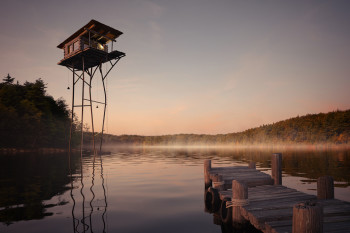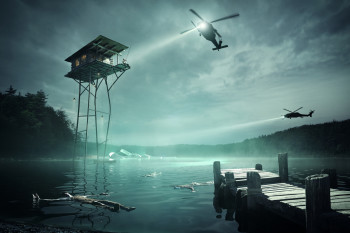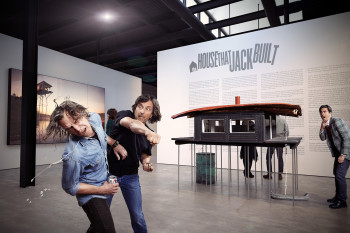Well, we had our first real fight in the Mercer Gallery last night. And the strange thing is, we were lucky that a black eye and a few bruised ribs was as bad as it got. Last night marked the opening of Jack Daws’s new exhibition, The House That Jack Built, and it was a queer collection of anarchists and poets, celebrities and activists, and one colorful character who claims to be the re-incarnation of Henry David Thoreau himself.
That last character, Jacques Henri, may or may not be the spiritual descendant of Mr. Thoreau, but he was the catalyst for Daws’s new foray into architecture, resulting though it did, in environmental catastrophe and ever-broadening legal troubles. It is difficult to start with the question of who Jacques Henri is exactly, but it is known that he contacted Daws and, after a lengthy correspondence, Daws was compelled to design and build a new private residence for Mr. Henri. In Concord, Massachusetts. In the middle of Walden Pond. Going up against the tyranny of bureaucracy, “The House That Jack Built” is a study in civil disobedience and the unfortunate consequences of a focused passion. Walden Three can exhibit the work of Daws, but it takes the words of the artist himself to describe the rabbit hole he found himself drawn into.
Please listen to his account by clicking the below audio:
 The House That Jack Built includes a visual narrative of his time in Concord and on Walden Pond, captured in 23 breathtaking photographs, as well as his architectural models and correspondences with Mr. Henri. News clippings and testimony of the ensuing environmental disaster (January 3, 2013) serve more as the connective tissue to the protests on Second Avenue (and inside Walden Three) that erupted throughout the weekend, primarily organized by the Earth Liberation Front (ELF). But it appears that not even the anarchists, environmentalists and Thoreau lovers could unify over the disaster on Walden Pond, as noted anarchist John Zerzan and environmental activist Derrick Jensen both came to Daws’s defense in not-so-subtle ways, claiming that what happened at Walden Pond is a drop in the toxic bucket of industrial waste and corporate degradation of our oceans, forests and agriculture. The gallery was as tense as a first grade soccer game in a lions den. Someone was bound to get hurt.
The House That Jack Built includes a visual narrative of his time in Concord and on Walden Pond, captured in 23 breathtaking photographs, as well as his architectural models and correspondences with Mr. Henri. News clippings and testimony of the ensuing environmental disaster (January 3, 2013) serve more as the connective tissue to the protests on Second Avenue (and inside Walden Three) that erupted throughout the weekend, primarily organized by the Earth Liberation Front (ELF). But it appears that not even the anarchists, environmentalists and Thoreau lovers could unify over the disaster on Walden Pond, as noted anarchist John Zerzan and environmental activist Derrick Jensen both came to Daws’s defense in not-so-subtle ways, claiming that what happened at Walden Pond is a drop in the toxic bucket of industrial waste and corporate degradation of our oceans, forests and agriculture. The gallery was as tense as a first grade soccer game in a lions den. Someone was bound to get hurt.
Daws has never been one to shy away from controversial issues (http://jackdawsart.com), but for this project, he believes the house he designed and built on Walden Pond was rather benign, a simple response to the growing trend of architects participating in the art world, both in exhibitions and public works projects. If architects could make art, then he could for damn sure get into architecture. He did not however, set out to address the sheer volume of toxic chemicals manufactured, transported and introduced into our food, land and water supply. And his intent was not to situate Jacques Henri in the middle of what is now an environmental disaster of the highest order. But in true Daws form, he created a powerful and important dialog about the role of the artist, the fallout of which continues to inspire volumes of hate mail. “They’re sending it to the wrong address,” said Daws. “All I did was build a house with some stolen train tracks. If they want to lay blame for what followed then they need to lay it on the Frankensteins who churn out toxic waste. They’re the reason no fish will ever live in Walden Pond again.”
As the opening night audience pushed through the protestors on First Avenue and made their way up to the Denny Gallery, there appeared to be a brief solidarity in support of the show, but that proved to be the first act in a long and volatile evening. Canadian singer/songwriter Hawksley Workman performed a short set on the Denny Stairs earlier in the evening before joining Marion Cotillard and her husband Guilaume Canet in the gallery. Rem Koolhaas and Mike Reynolds argued throughout the building with their own constellation of architecture students hovering about like moths around a streetlamp. Famed tree-sitter/protester/speaker Julia Butterfly Hill slipped into the gallery on the arm of a strapping, rugged gentleman whom Daws strongly suspected was Grant Hadwin (famed for cutting down the Golden Spruce and disappearing in the Hecate Straight). Perhaps the most light-hearted event of the evening occurred when Cornell West and Faith Ramos took over a corner of the gallery and managed to turn Civil War trivia into a drinking game.
There is a certain romantic notion that art could be so powerful as to provoke fistfights, and we experienced our first one last night. The gallery had mostly cleared out as the crowd migrated to the Dial and a few other private affairs around town. Architects Tom Kundig and Alan Maskin were late arrivals. Upon entering the gallery, Mr. Kundig walked with a focused intent, marching past extended hands and friendly faces. The footage of what happened next is pretty spectacular, but I think Daws summed it up best:
“I wish I’d’ve read his wikipedia page before I tried to rip off his style. If I’d’ve known he grew up on the mean streets of Spokane I might not’ve messed with him. When he walked up to me at the opening I thought he was coming over to introduce himself, so I went to shake his hand, but then he just balled up his fist and said, ‘I hope you like hospital food.’ You can ask anybody who was there, he definitely sucker punched me, but I ain’t going to cry about it. It’s a great way to win a fight, and he clearly knew that. I don’t know what else to say about it, the dude handed my ass to me in a paper bag.”
 The fight clocked in at about 13 seconds, as most fights do. Jed Dunkerley and Maurizio Cattelan pulled the two apart and eventually they both sat down and caught their breath, and took inventory of their cuts and bruised ribs. John Doe ran and got some ice from the bar and Miuccia Prada pulled a fifth of Lagavulin from her purse, which the two reluctantly pulled from. We locked up the gallery and left the two of them there, (which at the time seemed like a good idea) and proceeded down to the Dial for our own spirits. Maskin and I returned around 3 a.m. to find the scotch drained and the two nowhere to be seen. We found them later though, on the roof at dawn, plowing through a half-rack of Lucky Lager. They were trying to guess how far Seattle’s tunnel-boring machine would make it before finally getting stuck for good, and being abandoned altogether: the prospect of which they both found quite hilarious.
The fight clocked in at about 13 seconds, as most fights do. Jed Dunkerley and Maurizio Cattelan pulled the two apart and eventually they both sat down and caught their breath, and took inventory of their cuts and bruised ribs. John Doe ran and got some ice from the bar and Miuccia Prada pulled a fifth of Lagavulin from her purse, which the two reluctantly pulled from. We locked up the gallery and left the two of them there, (which at the time seemed like a good idea) and proceeded down to the Dial for our own spirits. Maskin and I returned around 3 a.m. to find the scotch drained and the two nowhere to be seen. We found them later though, on the roof at dawn, plowing through a half-rack of Lucky Lager. They were trying to guess how far Seattle’s tunnel-boring machine would make it before finally getting stuck for good, and being abandoned altogether: the prospect of which they both found quite hilarious.
Meanwhile, where was Jacques Henri? He had been camping in the woods behind Daws’s home on Vashon Island for the better part of the week, drinking green chartreuse, rolling his own smokes and sharing his homemade pâté with all that approached. He did walk through the gallery earlier in the day and seemed pleased with the exhibit, but wanted to avoid the spotlight that was guaranteed anyone claiming to be the re-incarnation of Thoreau. He asked a lot of questions about the Olympic rainforest and the popularity of neck beards. I did get the chance to ask him if he planned on staying on Walden Pond and he chirped “Survival in the face of hostile elements!” with a pointed finger and directionless stare. At about 9:30 he told Hawksley, “Now comes good sailing!” and that was the last we hear of him.
By Walden3 and guest blog writer Greg Lundgren



